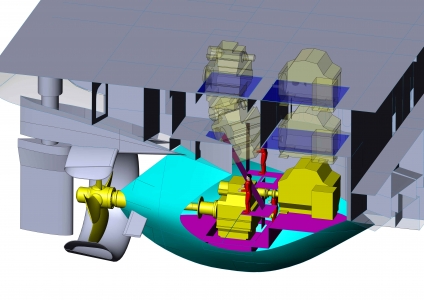January 11, 2016 – Cat® Propulsion’s revolutionary twin fin system offers substantial efficiency gains across a range of ship types
A new concept in ship propulsion developed by Caterpillar has triumphed at the 17th annual Platts Global Energy Awards in New York. Winning the Commercial Application of the Year category, the twin fin system secured the prestigious award for its innovative design and energy-saving potential across a range of ship types.

The Cat® Propulsion twin fin system is a new short-shaft diesel electric set-up which has already demonstrated significant fuel and emissions-saving benefits of up to 30% in installations on board two seismic survey vessels of Ulstein SX124 design. Caterpillar has now expressed confidence that the new engine solution will yield energy savings of at least [15-20%] for other vessel types.
The flexible new propulsion configuration also has a wide range of other benefits and is particularly well-suited to vessels operating in harsh conditions, notably ice. It comprises a compact electric motor and gearbox, connected via a short drive shaft to controllable pitch propellers, the performance of which is optimized by the two tailor-made fins attached to the hull. If dynamic positioning is required, tunnel thrusters can be attached either to the fins or on the central skeg between them.
Cat Propulsion Naval Architect Mattias Hansson, one of the designers of the twin fin system, reveals that the company has received a broad range of enquiries from ship operators in many different sectors – from offshore support vessels, dredgers and fishing vessels to ferries, cruise and research ships. The system is suitable both for new ships and retrofits aboard existing vessels. The fact that the twin fin system can be designed and manufactured in advance leads to significant time savings.
Hansson outlines some key features. “The fins are integrated parts of the hull,” he says, “but they can be prefabricated and installed easily and quickly. For conversions, this can reduce time out of service from, say, 100 days to around 30. We see significant opportunities in the retrofit market.
“The short shaft line – typically between two and four meters long – gives greater flexibility and allows larger propellers to turn more slowly, thereby raising efficiency and providing more thrust,” Hansson continues. “There are fewer moving parts leading to longer service intervals and reduced through-life maintenance costs and the fact that there is only one bearing leads to better propulsive efficiency. There is also significantly less noise and vibration, meaning that the system is well-suited to cruise-ship applications.”
There are a range of other benefits too. The revolutionary design effectively means that engine room space is moved outside of the ship’s hull but with full serviceability from inside the vessel. Not only does this provide more space and deadweight capacity within the hull, but it also means that the self-contained fins can be demounted without drydocking the vessel. Therefore the twin fin system protects all of the propulsion components within the hull profile while maximizing cargo space and the maneuverability performance associated with outboard propulsion systems.
The twin fin system was originally developed by Caterpillar in partnership with Odense Maritime Technology and Scandinavian Marine Group to reduce the risk of damage to propulsion systems on board vessels operating in the Arctic. Now, however, spectacular energy savings achieved on board the two seismic vessels indicate that the technology has a far wider range of possible applications.
About Caterpillar Marine
Caterpillar Marine, with headquarters in Hamburg, Germany, groups all the marketing and service activities for Cat® and MaK marine engines and propulsion systems within Caterpillar Inc. The organisation provides premier power solutions in the medium- and high-speed segments with outputs from 93 to 16,800 kW in main propulsion and 10 to 16,100 kWe in marine generator sets as well as a comprehensive portfolio of propulsion solutions. The sales and service network includes more than 2,100 dealer locations world-wide dedicated to support customers in ocean-going, commercial marine and pleasure craft wherever they are.
More information is available at: MARINE.CAT.COM/pr
